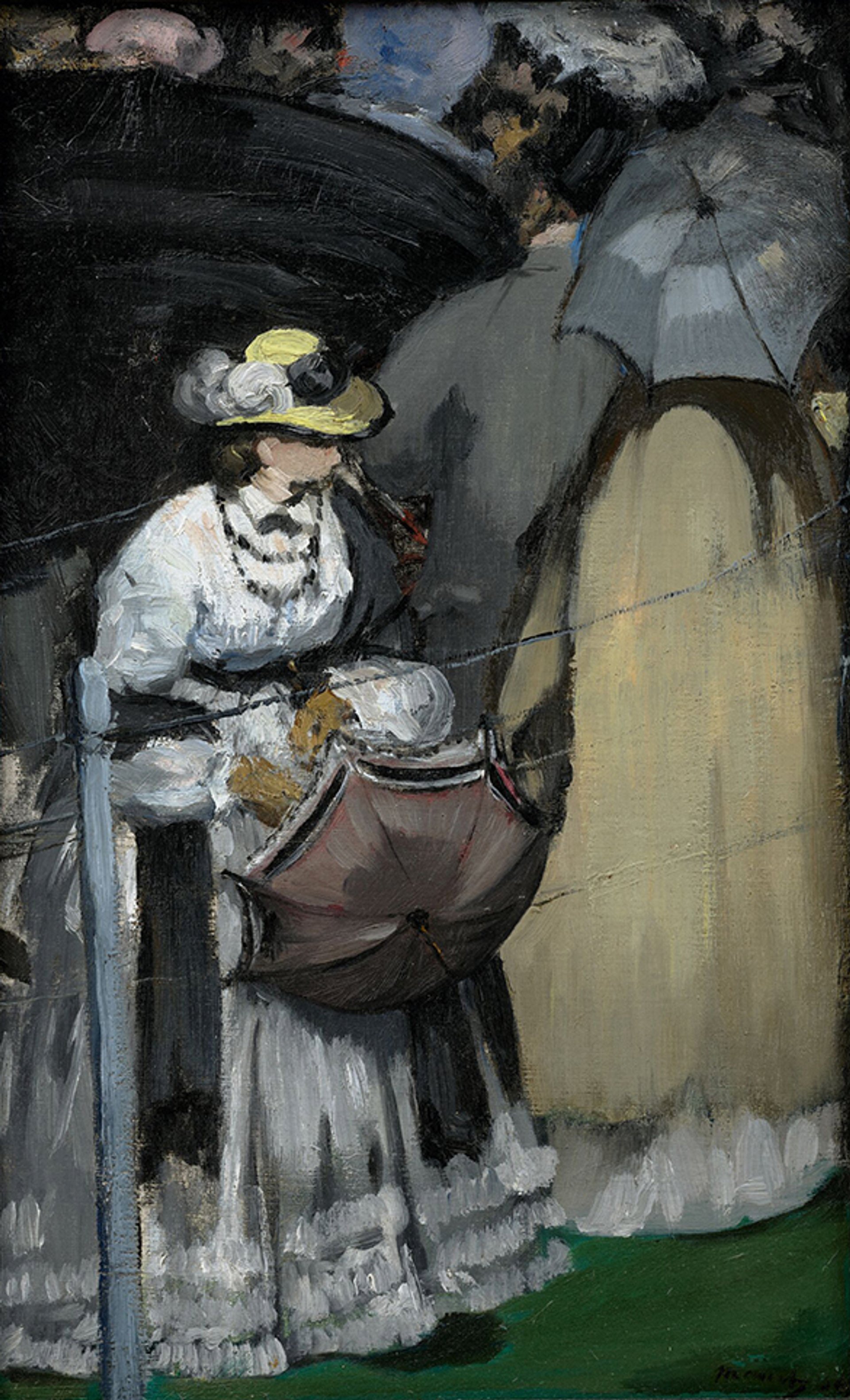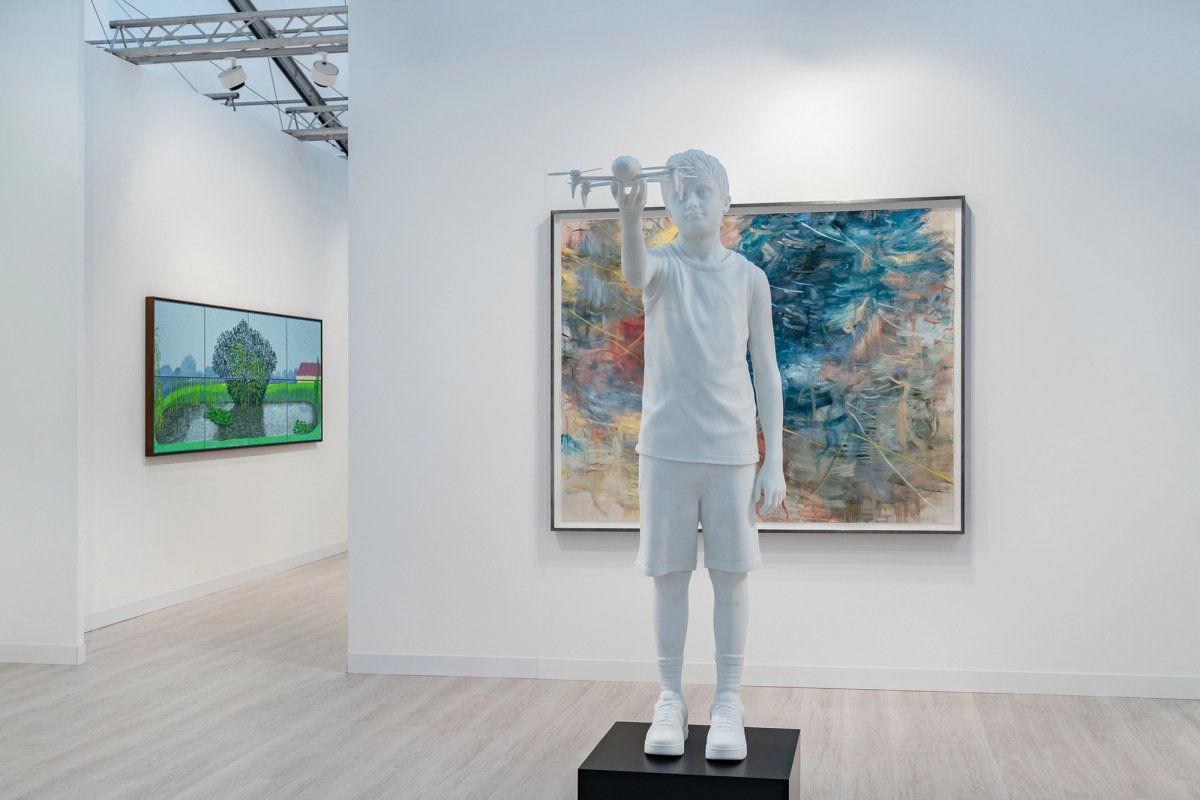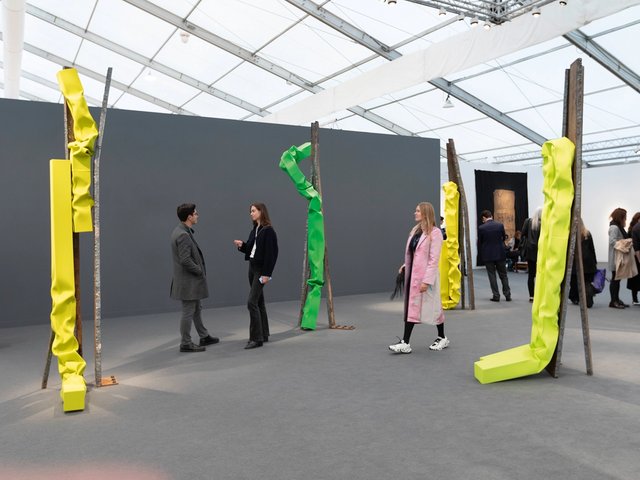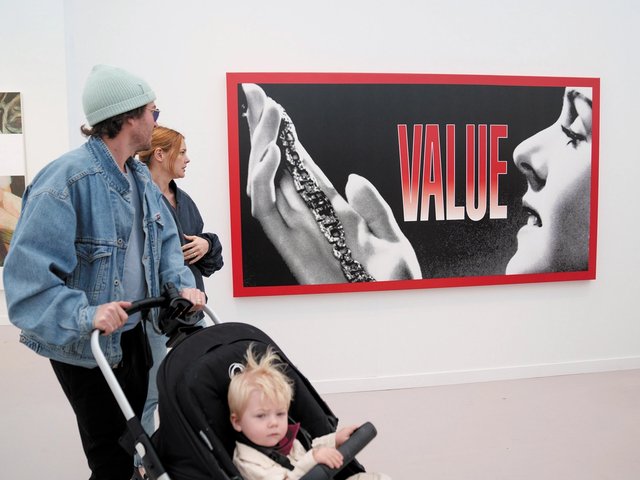Despite economic anxiety over rising costs, Brexit aftershocks, a volatile international political landscape and the looming return of rival fair Art Basel Paris at the Grand Palais, the VIP preview for Frieze London was as buzzy and busy as ever by the afternoon on Wednesday (9 October). Dealers were largely optimistic about sales, and generally happy with the venue’s new floorplan.
“There has been a softer market, but I think what happens inside the tent at the fair when you bring 160 galleries together is something that’s slightly different,” says Frieze London’s director Eva Langret. “It’s a bit of a bubble, and it follows its own rhythm. So far, we’ve had really exciting sales, and it’s going pretty well.”
The most valuable sales reported on the preview day all came from Hauser & Wirth’s stand at Frieze Masters. Arshile Gorky’s The Opaque (1947) sold for $8.5m, the gallery says, while a 1865 oil painting by Édouard Manet, Pelouse du champ de courses à Longchamp, fetched €4.5m, along with Elle danse (1948) by Francis Picabia for $4m. David Zwirner reported selling a painting by Lisa Yuskavage for $2.2m and two Yayoi Kusama paintings for $670,000 and $720,000.

Hauser & Wirth sold Manet’s Pelouse du champ de courses à Longchamp for €4.5m Courtesy of Hauser & Wirth
White Cube’s stand sold the late American artist Al Held’s painting D-Y (1979) for $450,000, the gallery says, along with Tracey Emin’s 2016 bronze I wanted more for £120,000. The gallery sold four other works from Emin’s 2023 series The Doors for £80,000 each. Pace says the most valuable work it sold during the preview was David Hockney’s 25th July-7th August 2021, Rain on the Pond (2021), but did not disclose a price. The gallery also sold a 2024 sculpture by Alicja Kwade for $500,000. Mid-range galleries also reported feeling optimistic about early sales figures.
Pleasantly surprised
Stephen Friedman Gallery from London sold out its stand of works by Caroline Walker and Clare Woods, both British artists, to buyers from the UK, Europe, the US and Asia, according to the gallery. Walker’s works were priced between £35,000 and £175,000 and Woods’s had a range of £45,000 to £70,000.
“As a gallery, we acknowledge that there has been a softening of the global market, but we are trying to make a lot of strategic decisions around that,” says Mary Cork, the gallery’s senior director. “We’ve been more than pleasantly surprised by the response, not just at Frieze, but our last couple of gallery shows. We’re certainly not going to take for granted that everything will be bouncing back, but it does feel like that for us as an individual gallery.”
Timothy Taylor, who has gallery locations in London and New York, has a solo stand dedicated to paintings by the New York-based artist Paul Anthony Smith. The works range in price from $35,000 to $85,000 and the gallery has made sales at each level, he says. “I’m not going to say, ‘Oh, we’ve got to batten down the hatches, it’s really tough’,” Taylor says. “Because, actually, it isn’t? Running a gallery is difficult, and you have to work hard, [during the] good times and bad times.”
Adam Green, a Dallas-based art adviser who works largely with American clients, travelled to London for Frieze Week. He says the fair reflects what he has seen in the art market over the past several months.
“There’s increased selectivity in terms of the works my clients—and collectors in general—are focused on,” Green says. “Primary prices increased a lot over the last few years, so I think they’re more selective about which artists they’ll pursue at these higher price points. I do think galleries are being a bit more flexible in terms of things like discounts to make sales happen.”
“The secret of being happy in the present day is to lower your expectations,” says dealer Richard Ingleby. “Being Scottish, and having had a lifetime of supporting Scottish football teams, I’ve learned to lower my expectations quite well.” His Ingleby Gallery in Edinburgh is dedicated to bringing international art to Scotland and representing Scottish art abroad. Work at the stand ranges in price from £2,500 to £150,000, and the gallery made multiple sales across that range, Ingleby says.
“We’ve had a great response to every single thing in the group. Maybe in some years, we might have expected that would mean that everything might have sold. That’s not the case now, by any means,” Ingleby says. “But enough of those conversations have come good and turned into sales, that we’re perfectly content at this moment, and it feels like we’re doing as we always do.”
Refreshed layout
The new, more open layout is meant to provide better sightlines for visitors walking through the fair and allow for more opportunities to discover new things, as well as making the atmosphere more “engaging and accessible”, according to Frieze. “The goal was to refresh the layout of the fair. Last year we celebrated our 20th anniversary, so it’s time to think about what the fair will look like for the next 20 years,” Langret says.
Most dealers at the fair told The Art Newspaper that response to the new layout had been generally positive, though it did create a bottleneck during the early hours of the fair: even 30 minutes after the VIP preview opened, dealers such as David Zwirner and Jay Jopling were seen milling about their stands, waiting for clients to work their way to the far end of the fair where the blue-chip galleries were located.
The co-founder of the Berlin gallery ChertLüdde, Florian Lüdde, says that the new layout is “very democratic” and, from his own observations, has not significantly changed the levels of attendance.
He says sales on Wednesday were “better than expected”, though the gallery still took a cautious approach and pre-sold several works by Álvaro Urbano and Monia Ben Hamouda. Yesterday, the gallery sold a plant installation work by Urbano for €60,000.
“The market, as we all know, has been pretty flat. But actually, I can see a real uptick. The booths are selling well, there’s a lot of interest,” says Lisson Gallery partner Louise Hayward. At Frieze London, Lisson showed a solo stand of work by Leiko Ikemura, a Swiss-Japanese artist whose paintings and sculptures were priced at between €50,000 and €168,000, of which ten sold. The gallery’s stand at Frieze Masters showed work by the Iranian artist Shirazeh Houshiary.
A tale of two cities
Lisson Gallery is also taking part in Art Basel Paris, which begins next week. It will be the French fair’s return to the Grand Palais, a venue that is drawing attention among collectors, dealers say. There has been some speculation that American buyers in particular will be drawn to the Parisian fair and possibly skip attending Frieze London.
There’s great energy here and London still has a serious audienceTimothy Taylor
“I love healthy competition,” Hayward says. “Art Basel being in the Grand Palais [after having usurped FIAC, the French contemporary art fair, from the venue] forces Frieze to up its game. They’ve radically changed the layout, everything’s better with Frieze Masters. There’s enough to go around.”
Timothy Taylor also dismissed the idea that fairs in London and Paris cannot coexist. “London’s holding it together. There’s great energy here and it still has a serious cosmopolitan audience,” Taylor says. “[Collectors] may not live here, partly due to UK tax, but they like it here. They come and spend time here, and Frieze is still a very important part of that.”




